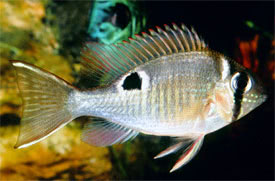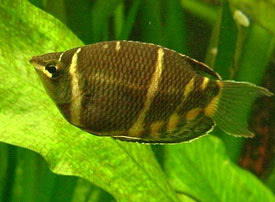
 Magyarul / Hungarian
Magyarul / Hungarian



- Scientific name: Biotodoma cupido
- Common name: Cupid cichlid
- Synonyms: Acara subocularis, Geophagus cupido, Mesops cupido
- Group: Cichlids
- Habitat: South America, Central Amazon, western Guyana
- Size: 14 cm.
- Biotope: Sandy or muddy bays with no current to mention.
- Social behavior: Territorial, aggressive and intolerant, the fish form monogamous pairs and a nuclear family. A burrower. Problems with pairing are common, so allow a group of youngsters to pair off, and select the best pair.
- Diet: Carnivorous; all types of live foods such as water fleas, tubifex worms, mosquito larvae and earthworms.
- Breeding: Quite hard
- Tank: Minimum 200 litres.
- Population: 1 male, and 2-3 females for 200 litres
- Decoration: Place rocky formations against the rear glass of the tank, creating caves and other hiding places. Add hardy plants and in the foreground place sand and a few rocks. Diffuse lighting will greatly enhance the coloration of the fishes and their well being. The filtration should not be too powerful, as strong currents are not enjoyed.
- Temperature: 26-29 °C
- pH: 6.5-7.5
- Hardness: 0-4 NK°
- Lifespan: 3-5 years
Description: In Biotodoma cupido the lateral spot lies above the upper lateral line, only a short distance from the dorsal, and is bordered anteriorly and posteriorly by a number of whitish areas. A number of narrow vertical bars are visible on the flanks. The body base colour is light brownish with a silvery sheen. Depending on locality, older specimens may, however, exhibit very beautiful markings on the body, iridescing in all the colours of the rainbow. Peruvian specimens have a distinctly yellow zone behind the operculum, while fishes imported from the Santarém region have bright yellow-orange flanks and a bluish green sheen all over the body. The dorsal and pelvic fins are elongated, and the caudal fin is fan-shaped. The dorsal and anal fins of the male are pointed. Wild-caught specimen are much more colorful, although they are also far more delicate.
Only adults exhibit clear sexual dimorphism differences: males have iridescent bluish horizontal lines be neath the eye, while in females these lines are broken up into dots. Unfortunately only dominant females exhibit these typical markings, while younger or subordinate females have just one faint interrupted line. Males grow somewhat larger and are more slender than females. It is virtually impossible to sex half-grown specimens. Biotodoma cupido is a rather unaggressive fish which appreciates peace and quiet in the aquarium. Rapid swimmers, greedy feeders, and aggressive species are not ideal tankmates, although it should be noted that during the breeding season significantly larger fishes will be driven away.
For breeding use water with a pH from 6.0-6.5, a water hardness of 0-4 dH, and a temperature from 81-84 F (27-29 °C). During spawning the female makes a hollow with its mouth; the male does not help. The spawn goes into this hollow. The eggs are approximately 2mm long, grayish-white and either stick to the ground or clump together. The female cares for the eggs, sometimes numbering over 100. When they are free-swimming about 10 days later, they can be fed roftiers and liquid foods. After a week or two, they are large enough to be given brine shrimp nauplii. The parents continue their care for the young. The fry are difficult to raise.





